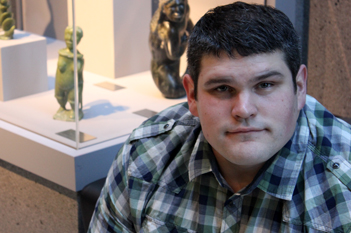
Building bridges
John Desjarlais Jr. (BE’11)—the 2015 recipient of the USSU Young Alumni Excellence Award—is one of those people.
By Derrick KunzWe all know someone who has that impulse to know how things work. They take things apart to see what makes them tick. They reassemble the items, not always according to the original design, seeking to improve functionality. They see things in a logical, progressive, orderly way.
"I want to problem solve, to break things down," Desjarlais explained. "I was just built that way. That's the way I think."
So it comes as no surprise that Desjarlais is an engineer—a maintenance engineer at Cameco Corporations' Key Lake mine site, to be specific.
A Métis resident of Cumberland House, Sask., Desjarlais started down the path of science, technology, engineering and mathematics (often referred to as STEM) long before post-secondary school. "My family was a major influence. My father was my first role model, my biggest role model," Desjarlais said. "I also had great educators, in secondary school right through post-secondary, great teachers in science, physics, biology. I had an environment to nurture the seeds and keep them growing."
He began his formal pursuit of engineering with NORTEP-NORPAC—post-secondary programs for Northern Saskatchewan residents of Aboriginal ancestry—and later switched to Northlands College to obtain certification as a radiation environmental monitoring technician.
After working with Cameco for five years, Desjarlais felt it was the right time to go back to school, beginning his studies at the U of S College of Engineering.
While a student, Desjarlais discovered that students from rural and remote locations were struggling—both culturally and academically—and had a comparably high drop-out or fail rate. Instead of sitting idly by, he helped develop the Northern Administrative Student Association (NASA) to help bridge home life and the at times overwhelming university experience.
He also helped revitalize the Indigenous Students' Society (ISC). As president, he brought in new policies and procedures that would allow the struggling student group to better serve the needs of the growing number of Aboriginal students on campus.
"We needed to rebuild the purpose and culture [of the ISC]. We got involved in Aboriginal Student Week, we hosted cultural events, and we built credibility with students and the university—with both Aboriginal and non-Aboriginal people."
Desjarlais continues to help students adapt to university life and promote study in STEM fields. He was an Alumni Namesake Mentor for the university's Learning Communities, "mentoring the mentors who engage with students and help them transition during their first couple months" at the U of S. He is also an advisor for engineering students working on their capstone design project.
As chair of the Association of Professional Engineers and Geoscientists of Saskatchewan's sub-committee on Aboriginal initiatives, Desjarlais helps fellow Aboriginal engineers bridge from student to working professional. "It's great to have the support of the college, from people like Matt Dunn [Indigenous peoples initiatives coordinator in the College of Engineering] and an active engagement strategy."
Now pursuing his master of business administration with the Edwards School of Business, Desjarlais is getting a rounded business perspective and sees endless opportunities for business and organizational development in Aboriginal communities and organizations.
True to his "fixer" nature, Desjarlais recognizes opportunities to improve things. "I could work with individuals or Bands or communities, bridging gaps and building capacity...structure, business proposals, pursuing potential sponsors... If that turns into a business opportunity, that would be fantastic."

